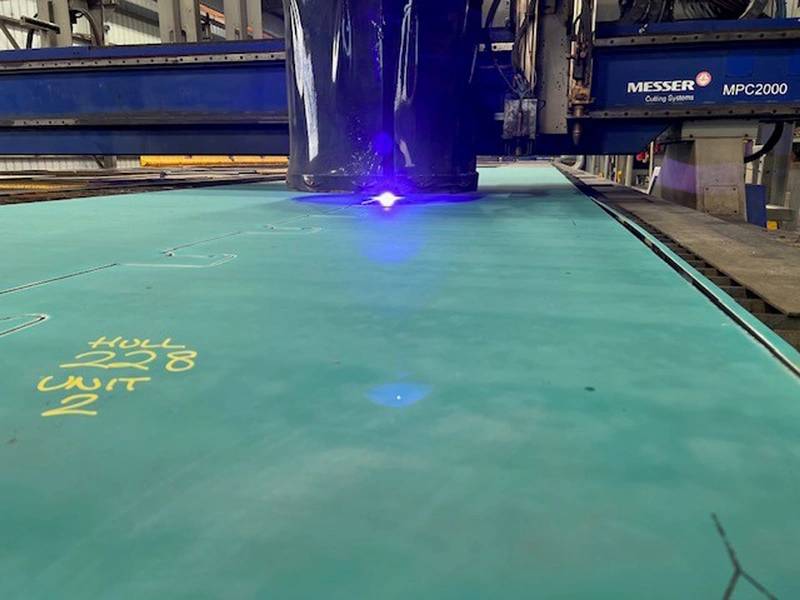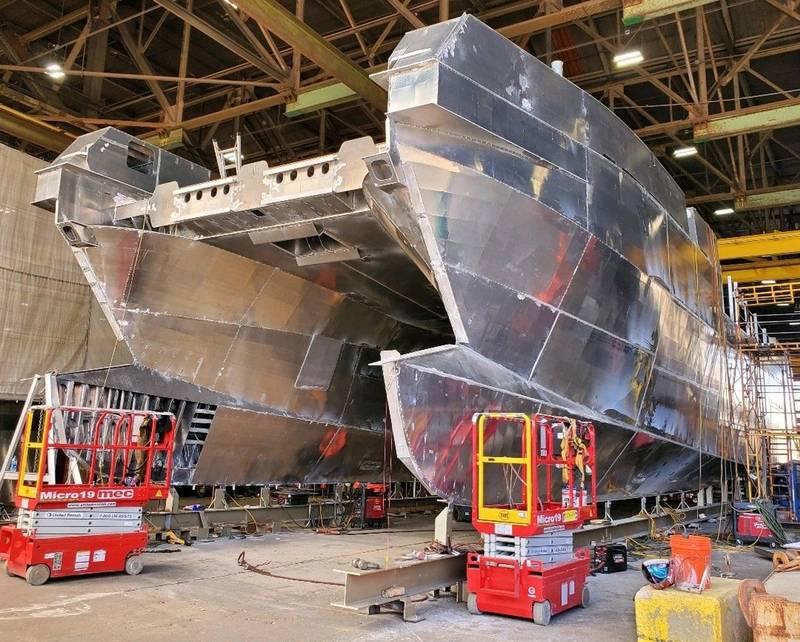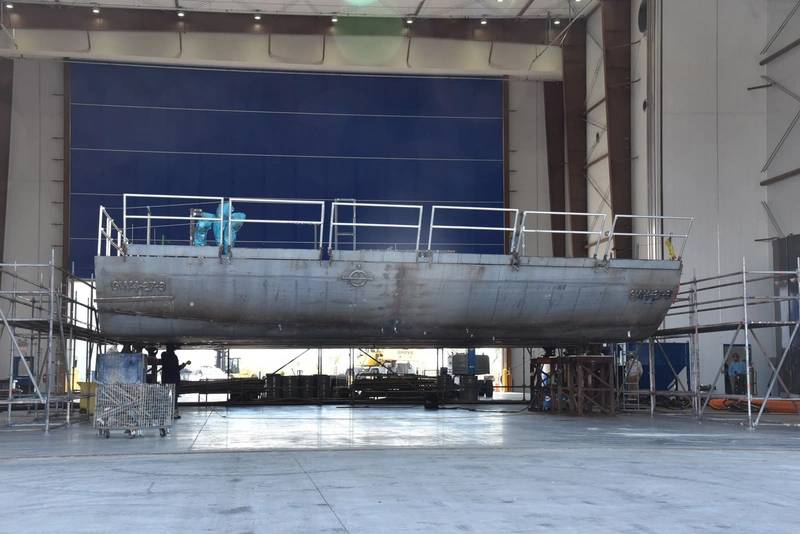
2023 US Shipbuilding Report
Much has changed since Marine News’ 2022 shipbuilding report published in March last year, and business opportunities in certain market segments continue to grow. But the shipyards that are looking to cash in are still facing many of the same challenges.
For example, many American shipyards and their partners throughout the shipbuilding supply chain are still finding it difficult to attract and retain the workers they need. If you’re a skilled craftsperson looking for a job in shipbuilding, you’re in luck, because there are plenty of openings at shipyards across the country. Job fairs and hiring events are becoming more commonplace, while some yards, such as HII’s Ingalls Shipbuilding, are getting creative. The Pascagoula, Miss., shipbuilder has opened an on-site Chick-fil-A and is offering Wi-Fi i to help woo the next generation of shipyard workers.
In addition, the impacts of historically high inflation are being felt across sectors, placing pressure on shipyards, which tend to engage in fixed-price contracting. Going forward, cost concerns could potentially stall some newbuild order plans, or in the case of offshore wind, lead operators to examine retrofit options over the previously preferred newbuilds. But in most instances, vessels still need to be built; they’re just going to be more expensive.
At the close of 2022, Philly Shipyard in Philadelphia reported a record high order backlog of more than $2.1 billion, with contracts to build the Maritime Administration’s (MARAD) five National Security Multi-Mission Vessels (NSMV), a subsea rock installation vessel for Great Lakes Dredge & Dock and three 3,600 TEU Aloha Class LNG-fueled containerships for Matson for deliveries scheduled out to 2027. But the builder warned in its Q4 2022 report that its “forecast continues to be negatively impacted by significant delays, productivity loss and increased costs, including costs of labor, materials and logistics issues.” Philly Shipyard said it expects COVID-19 impacts such as “risks to human capital resources arising from vaccine mandates, supply chain constraints, labor and raw materials shortages and inflation” will continue even as the pandemic retreats.
Certainly, supply chains have improved some over the past 12 months, but the situation is still far from perfect, with long lead times and delays hindering newbuild projects of all shapes and sizes. A builder of rigid hull inflatable boats (RHIB) recently told Marine News it had to swap the brand of outboards it typically uses for most builds because it simply couldn’t source the volume it needs.
Asked about supply chain concerns, Garrett Rice, president at Master Boat Builders in Coden, Ala., said, “We've run into some issues, but nothing that has been insurmountable. We've been able to work our way through it and find the product where we need to get it and when we need to get it. The supply chain is just tough in general. Building series of boats is always nice because you have that long backlog. But right now, in order to meet schedule, we've even had to buy a lot of material up front for multiple boats: four, five, six at a time. Get it all to the yard, pay for it all up front. That way we have security in the fact that we have it when we need it.
“Four years ago, we would order [certain items] and say deliver it on four-month intervals, and there'd be no issue. They'd deliver it every four months or three months, whatever the schedule dictated,” Rice said. “But now, we just don't have that trust in the supply chain that when we need to get it, it's going to be available. So, we're having to place large orders, store things ourselves, get a lot of equipment here early, which is good for the customer, but it's just different than it once was.”
 Eastern Shipbuilding Group is building a new auto and passenger ferry for the Bridgeport & Port Jefferson Steamboat Company. (Photo: Eastern Shipbuilding Group)
Eastern Shipbuilding Group is building a new auto and passenger ferry for the Bridgeport & Port Jefferson Steamboat Company. (Photo: Eastern Shipbuilding Group)
Going green
Master Boat Builders, which has been delivering a steady stream of tugs, with a number of new orders on the books—including vessels for Bay Houston Towing, Suderman & Young and Moran Towing—has as emerged as one of the U.S. yards helping to lead the charge toward greener vessel operations. Notably, it is currently building Crowley’s eWolf, the first zero-emissions, all-electric ship assist tug in the United States. The highly anticipated 82-foot harbor tug is expected to be completed and ready for service at the Port of San Diego later this year.
Another first-of-its-kind vessel currently under construction and designed for cleaner operations is Maritime Partners’ Hydrogen One towboat, being built at Intracoastal Iron Works in Bourg, La. The groundbreaking vessel will run on emissions-reducing methanol-to-hydrogen generator technology—without diesel propulsion, for operator American Commercial Barge Line (ACBL). ACBL has recently order two other notable vessels: an EPA Tier 4 retractable towboat from Bayou La Batre, Ala. shipbuilder Steiner Construction Company, and an 11,000 horsepower (HP) class towboat from C&C Marine and Repair in Belle Chasse, La. For delivery in Q4 2023 and Q3 2024 respectively.
But nowhere has the “green” shift been more apparent than in the passenger vessel sector (covered extensively in the February 2023 edition of Marine News). In January, the Federal Transit Administration (FTA) announced $384.4 million in grant awards to 23 projects in 11 states and the U.S. Virgin Islands to expand and improve the nation’s ferry service, as well as accelerate the transition to zero emission transportation.
In addition, The San Francisco Bay Area Water Emergency Transportation Authority (WETA) is currently investigating both clean marine propulsion technology and shoreside infrastructure needs as it expects to order only zero-emission passenger ferries going forward.
Up the coast, the Washington State DOT (WSDOT) will launch a competitive bid process for the construction of its next hybrid-electric ferries after negotiations stalled with shipbuilder Vigor over cot and contracting disagreements. The five vessels will be bid out as a single program to Washington shipbuilders, though other yards outside the state could potentially compete for the project if local bids come in at too high a price. The state estimates the program to be worth about $1 billion.
Along the East Coast, Casco Bay Line (serving islands in coastal Maine, out of Portland) selected Senesco Marine to build a double ended hybrid electric ferry to replace an existing diesel vessel. The North Kingston, R.I. shipyard has also been selected to build a hybrid-electric passenger/vehicle ferry for the Maine State Ferry Service (MSFS). And slated to come online in NYC is a new zero-emissions electric high-speed ferry operated by New York Cruise Lines subsidiary New York Water Taxi on the Hudson River between Brooklyn and Manhattan. The carbon-fiber vessel is scheduled for launch in 2024, though a builder has yet to be announced.
The Texas Department of Transportation (DOT) will be taking delivery in 2023 of Esperanza “Hope” Andrade, a double ended vessel built at the Gulf Island Fabricators facility in Louisiana, with batteries to supplement its diesel electric powerplant.
The rise of offshore wind
Unprecedented opportunities also exist in the United States’ fast-growing offshore wind industry, where a large number of new vessels will be needed to support the construction and operation of wind farms due to sprout up in several U.S. regions.
“The foundations are firmly in place to support the deployment of 30 gigawatts (GW) of offshore wind by 2030 and 110 GW by 2050," said Phil Lewis, director of research at Intelatus Global Partners. “Yet despite the demand drivers and local content preferences supported by the Jones Act, there has been relatively limited newbuilding activity for crew transfer vessels (CTV) and service operations vessels (SOV) in the U.S.”
Several U.S. shipbuilders are already active building CTVs, including Blount Boats and Senseco Marine in Rhode Island, Gladding-Hearn Shipbuilding in Massachusetts, St. Johns Ship Building in Florida and Gulf Craft in Louisiana, but Lewis noted that each has certain capacity limitations and that the demand for these vessels will be strong—potentially hundreds over the coming decade. Lewis and Intelatus have identified at least 30 other U.S. shipyards capable of building CTVs to meet this demand.
 Senesco Marine is building crew transfer vessels for fellow Reinauer company WindServe Marine, an early entrant to the United States fast-growing offshore wind industry. (Photo: WindServe Marine)
Senesco Marine is building crew transfer vessels for fellow Reinauer company WindServe Marine, an early entrant to the United States fast-growing offshore wind industry. (Photo: WindServe Marine)
In the SOV segment, Edison Chouest Offshore is building two vessels across its Gulf Coast shipyards, and Fincantieri Bay Shipbuilding is building another in Sturgeon Bay, Wis. for Crowley's CREST Wind joint venture with ESVAGT. Lewis said he anticipates further SOV activity for a broad spectrum of U.S. yards and suppliers in the coming years.
To date, just one yard, Keppel AmFELS in Brownsville, Texas, is building a Jones Act-compliant wind turbine installation vessel (WTIV), Charybdis for Dominion Energy. It is currently expected that most foundation and turbine installation work will be performed by foreign flagged ships supported by Jones Act tug and barge feeder spreads, presenting yet another opportunity for U.S. shipyards. Kirby Marine Offshore, for example, has committed to build two feeder barge and diesel-electric hybrid tugboat units for its partnership with Maersk.
While the industry continues to battle significant economic headwinds, tax credits in the Biden administration's Inflation Reduction Act (IRA) combined with new funding initiatives for offshore wind vessels could help investors to commit to new construction. MARAD last year announced the designation of offshore wind vessels as Vessels of National Interest for support through the Federal Ship Financing Program, giving these applications priority for review and funding. “The program assists the domestic shipbuilding industry, providing support for U.S. shipyards to modernize their facilities, to build and retrofit vessels, and to assist U.S shipowners to cost-effectively obtain domestically produced new vessels,” the White House said.
Government shipbuilding
In addition to commercial work, America’s shipyards are also building vessels for the U.S. Navy, U.S. Coast Guard, U.S. Army, National Oceanic and Atmospheric Administration (NOAA), MARAD, local and state government customers. Notable shipbuilding programs include the aforementioned NSMVs under construction at Philly Shipyard; a pair of oceanographic research ships, Oceanographer and Discoverer, being built by Thoma-Sea Marine Constructors, in Houma, La. for respective deliveries in 2025 and 2026; and the Polar Security Cutter program underway at Bollinger Mississippi Shipbuilding (previously VT Halter Marine) in Pascagoula, Miss.—the series’ first vessel Polar Sentinel is scheduled to be launched in 2025.
In June last year, Mobile, Ala. shipbuilder Austal USA was awarded a contract to build up to 11 medium-endurance Offshore Patrol Cutters (OPC) for the U.S. Coast Guard. The initial $208.26 million award supports detail design and long lead-time material for one OPC, with options for production of up to 10 additional vessels, the Coast Guard announced on Thursday. The deal could be worth up to $3.33 billion if all options are exercised. The first four Heritage class OPCs are being built by Eastern Shipbuilding Group in Florida.
Among other noteworthy government shipbuilding programs awarded over the last 12 months is Denver-based Birdon America, Inc.’s contract awarded in October 2022 for the detail design and construction for the Coast Guard’s new river buoy and inland construction tenders. The deal includes options for the construction of a total of 16 river buoy tenders and 11 inland construction tenders, and the total contract value is estimated at $1.19 billion if all line items are exercised. Louisiana-based Bollinger Shipyards has been subcontracted to build the hulls.
Government shipbuilding programs, as well as other vessel types such as pilot boats, patrol and fast craft will be covered in great depth in future issues of Marine News, so stay tuned.
 The first steel module for the U.S. Navy’s T-ATS 11 under construction at Austal USA. The Mobile, Ala. shipbuilder is also building several other government programs, including the USCG’s second group of Offshore Patrol Cutters. (Photo: Austal USA)
The first steel module for the U.S. Navy’s T-ATS 11 under construction at Austal USA. The Mobile, Ala. shipbuilder is also building several other government programs, including the USCG’s second group of Offshore Patrol Cutters. (Photo: Austal USA)
Read 2023 US Shipbuilding Report in Pdf, Flash or Html5 edition of April 2023 Marine News
Other stories from April 2023 issue
Content
- Interview: Jennifer Carpenter, AWO page: 08
- Floating Offshore Wind: New Seascape, New Challenges page: 20
- Ammonia-powered Tug Conversion Underway page: 26
- 2023 US Shipbuilding Report page: 30
- Fuel Savings Are Just a ‘Nudge’ Away page: 36


